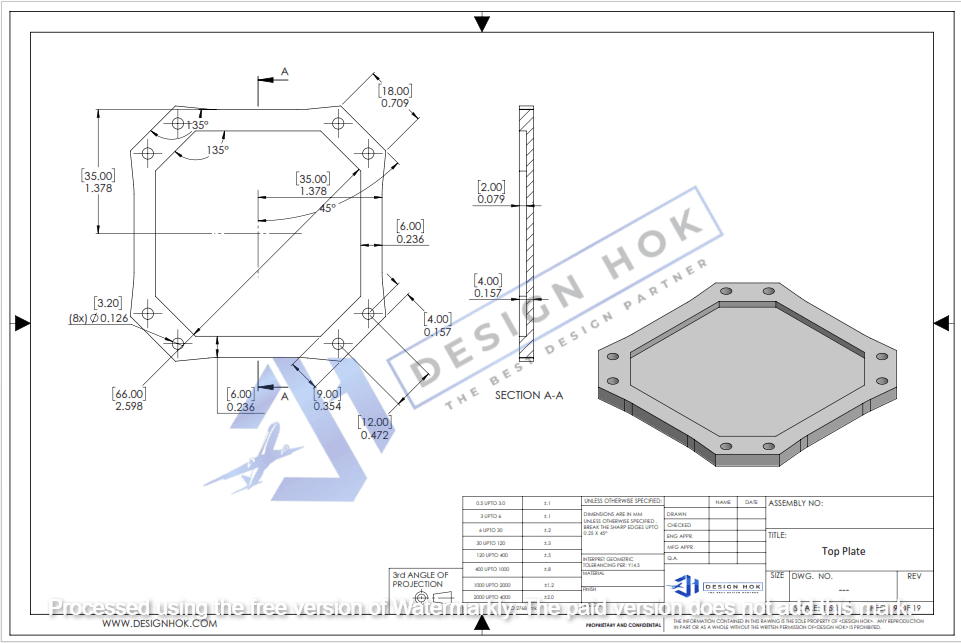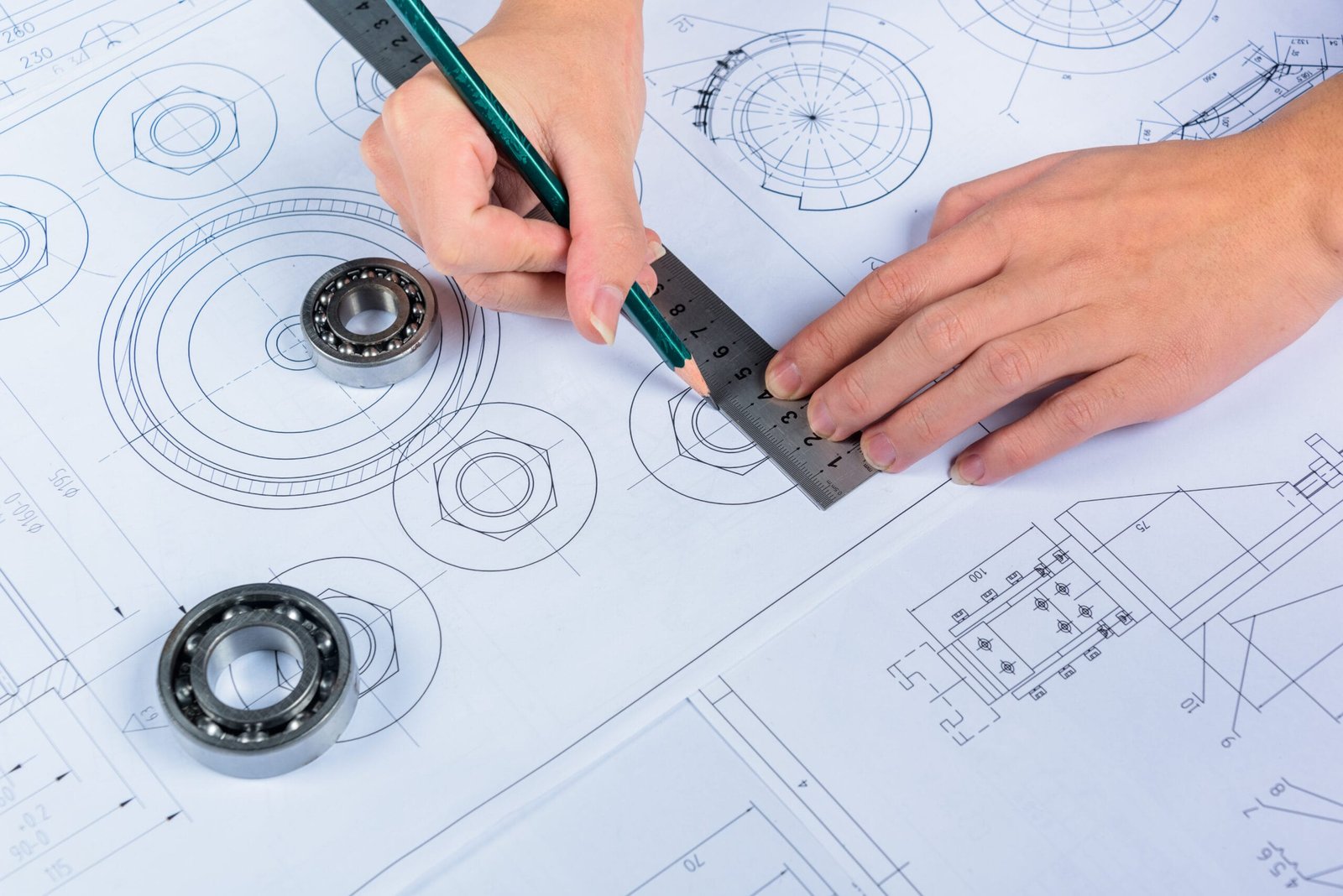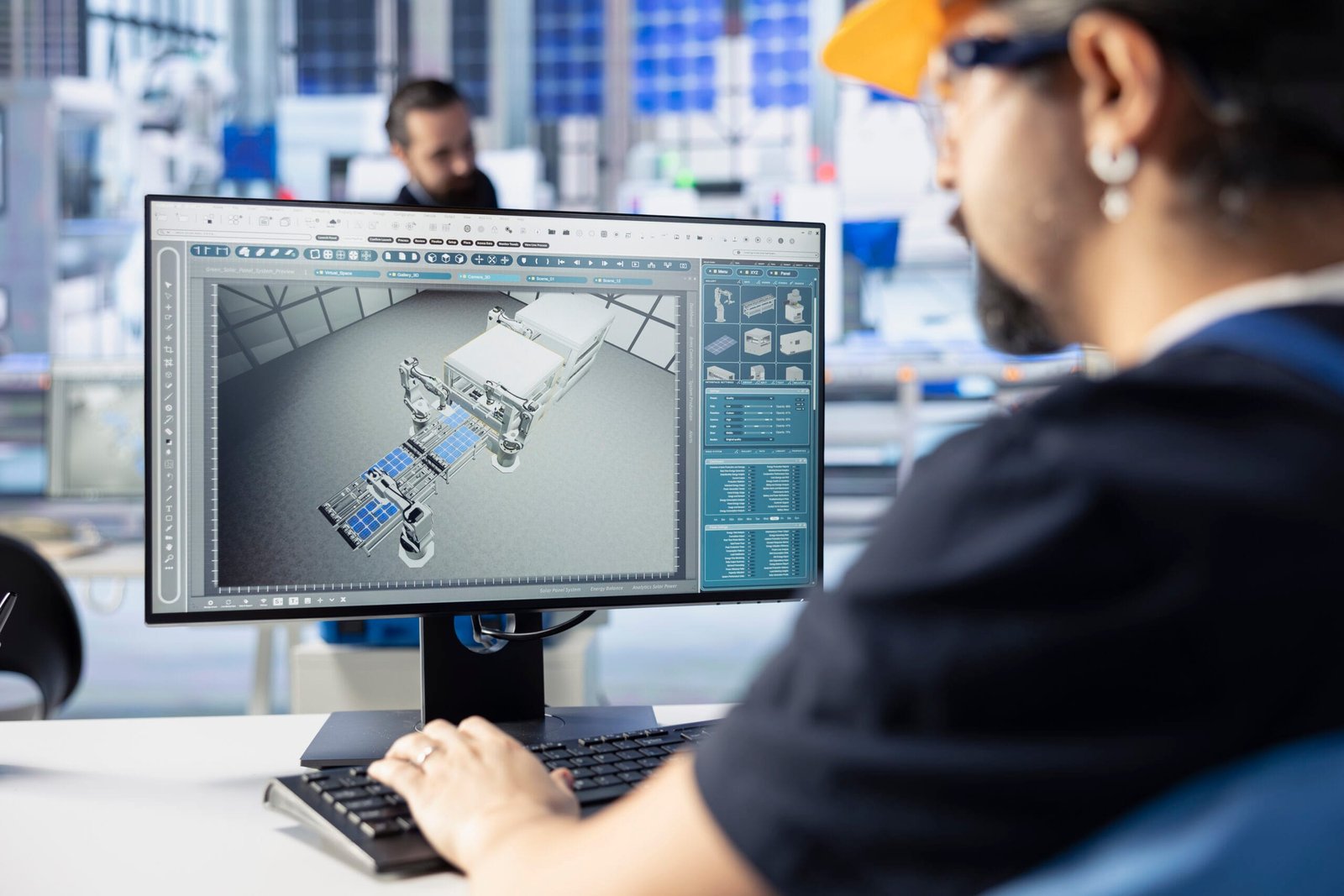AS 9100 Mechanical and Aerospace Design plays a big role in making things like airplanes, rockets, and defense systems work safely and effectively. But how do companies ensure these products are made with high quality and meet global standards? The answer lies in a powerful system called AS 9100.
In this guide, we will explore how AS 9100 Mechanical and Aerospace Design applies to mechanical and aerospace design, what the standard includes, how companies can meet it, and why it matters. This article is written in simple words to help designers, engineers, and businesses understand this important topic.
What is AS 9100 in Mechanical and Aerospace Design?
AS 9100 in Mechanical and Aerospace Design is a quality management standard made for the aerospace, defense, and aviation industries. It was created by the International Aerospace Quality Group (IAQG) and is based on the ISO 9001 standard. However, it adds special rules that focus on product safety, design, risk management, and supplier control for aerospace.
If your company designs or builds aerospace or mechanical parts, AS 9100 helps make sure you’re doing it safely and correctly. Many major companies like Boeing, Airbus, and Lockheed Martin only work with AS 9100-certified suppliers.
Why AS 9100 Matters in Mechanical and Aerospace Design
AS 9100 in Mechanical and Aerospace Design is the first step of any product, and in aerospace, that design must be precise and safe. A small design mistake can lead to big problems, even disasters.
AS 9100 helps:
- Improve product quality
- Make sure all parts meet safety and design rules
- Reduce errors, waste, and rework
- Manage risks early in the design process
- Show customers that you follow industry standards
If you are a mechanical or aerospace designer, understanding AS 9100 will help you create better products and grow your business.
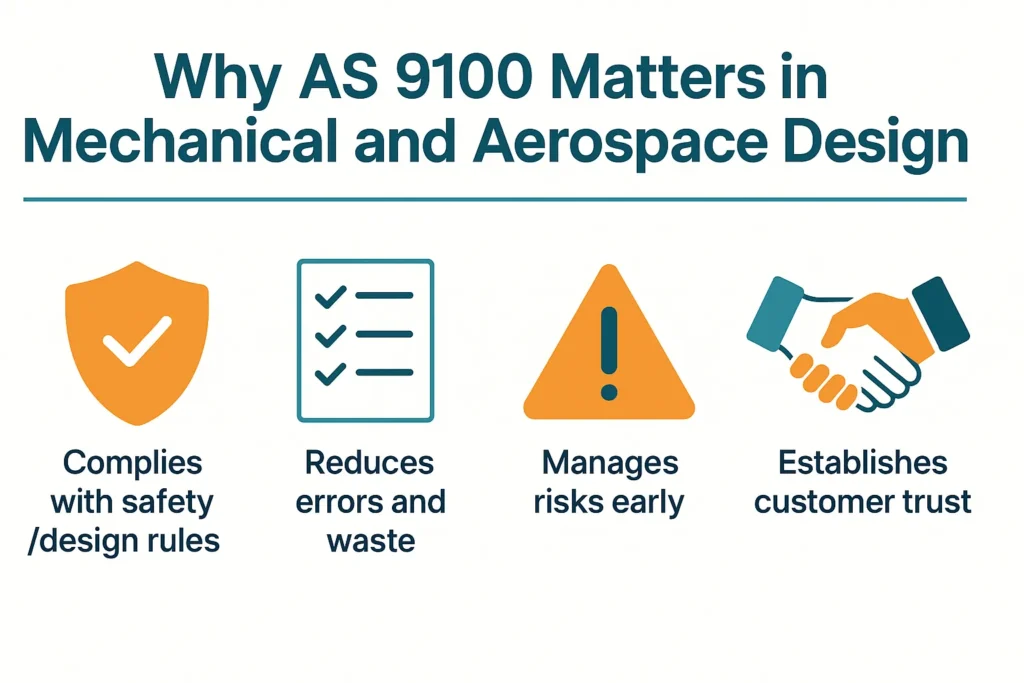
AS 9100 in Mechanical and Aerospace Design Process
Let’s break down how AS 9100 connects to each stage of mechanical and aerospace design.
1. Understanding Customer Requirements
The standard begins with clearly understanding what the customer needs. This includes:
- Technical specifications
- Material requirements
- Safety needs
- Legal or regulatory rules
Designers must record these requirements and use them as a base for all future steps.
2. Design and Development Planning
AS 9100 requires design planning. That means you must:
- Identify who is responsible
- Create a timeline
- Define tools and software to use
- Think about risks early on
This planning helps prevent problems later in production.
3. Design Input and Output
Design inputs include customer needs, legal requirements, and industry standards. Design outputs are your final design documents, CAD files, or mechanical drawings.
AS 9100 ensures that:
- Inputs are complete and correct
- Outputs meet input requirements
- Outputs are easy to read and follow in production
4. Design Review and Verification
Your team must regularly review the design to catch mistakes early. This may involve:
- Peer reviews
- Simulations or testing
- Verifying that the design works in the real world
If needed, redesigns should be made and documented.
5. Design Validation
Validation means checking that the product works as the customer wants it to. This may involve building a prototype, testing it under real conditions, and getting feedback.
AS 9100 ensures you keep records for all validation steps.
6. Configuration Management
Configuration means managing design versions. You must:
- Track changes in designs
- Make sure only approved versions are used
- Keep history of who made changes and why
This prevents errors in manufacturing due to using old or wrong files.
Key AS 9100 in Mechanical and Aerospace Design Requirements for Teams
Let’s look at some important parts of AS 9100 that relate to mechanical and aerospace design:
| Clause | Description |
|---|---|
| 7.1 | Planning of product realization – planning design and development |
| 8.3 | Design and development of products and services |
| 6.1 | Actions to address risks and opportunities |
| 8.4 | Control of external suppliers involved in design or parts |
| 10.2 | Nonconformity and corrective action |
Designers must work closely with engineers, quality teams, and suppliers to meet these rules.
Benefits of Using AS 9100 in Mechanical and Aerospace Design
Adopting AS 9100 brings several benefits to your design process:
✅ Better Quality and Fewer Errors
Using structured design reviews and validation avoids costly mistakes later.
✅ Increased Customer Trust
Certified companies show clients they take safety and quality seriously.
✅ Better Risk Management
By planning and identifying risks early, you reduce delays and problems.
✅ Easier Global Trade
Many countries and companies accept AS 9100 as a key requirement.
✅ Continuous Improvement
AS 9100 includes tools to help you improve your design process over time.
Common Challenges in Applying AS 9100 in Mechanical and Aerospace Design
❌ Lack of Awareness
Some design teams are not trained in AS 9100 requirements. Regular training is important.
❌ Poor Documentation
Design inputs, changes, and reviews must be well recorded and controlled.
❌ Miscommunication
If design teams and production teams are not aligned, errors can occur.
❌ Overcomplicating the System
It’s important to follow AS 9100, but keep things simple and clear for your team.
Best Practices for AS 9100 in Mechanical and Aerospace Design Compliance
To meet AS 9100 smoothly, here are some best practices:
- ✅ Use version control tools for CAD files and documents
- ✅ Conduct formal design reviews with cross-functional teams
- ✅ Keep checklists for input, output, review, and validation steps
- ✅ Use design risk assessment tools like FMEA (Failure Modes and Effects Analysis)
- ✅ Train design teams on AS 9100 rules
- ✅ Keep all records in an organized digital format
AS 9100 in Mechanical and Aerospace Design Tools
Many design teams use CAD (Computer-Aided Design) software. Tools like SolidWorks, CATIA, AutoCAD, or Siemens NX can support AS 9100 compliance when used with:
- Secure version control
- Design check templates
- Integration with document management systems
This helps ensure your mechanical or aerospace designs are traceable, reviewed, and approved.
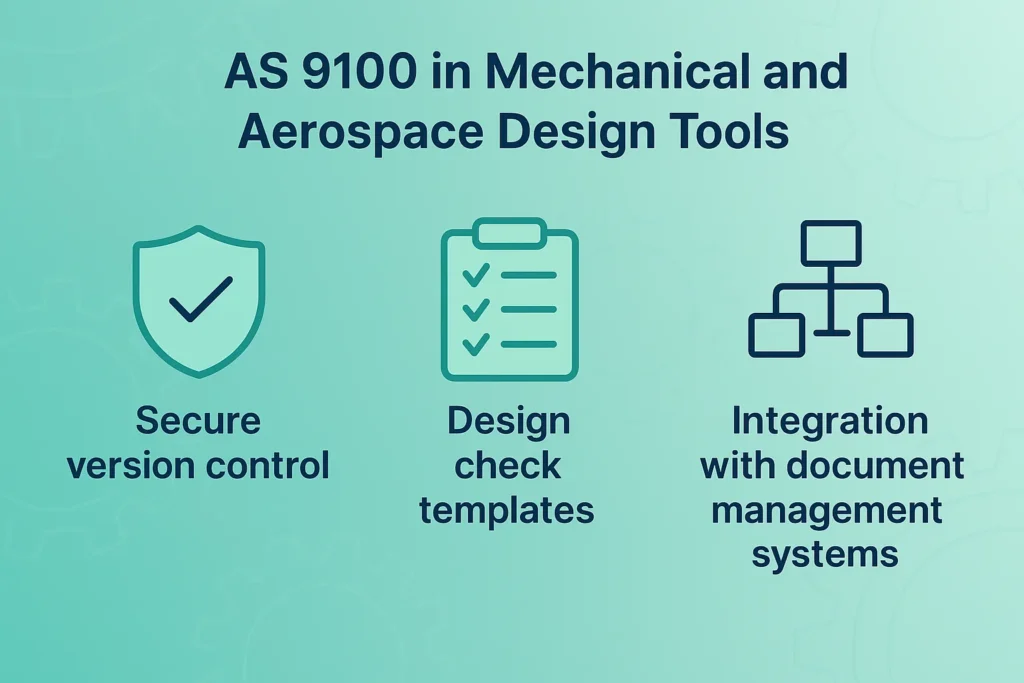
Integrating AS 9100 in Mechanical and Aerospace Design with Other Quality Systems
If your company already follows ISO 9001, IATF 16949 (for automotive), or ISO 13485 (for medical devices), then you can integrate AS 9100 easily. Many of the core ideas are similar:
- Risk-based thinking
- Customer focus
- Process control
- Continual improvement
Integration helps reduce duplication and creates a smooth, company-wide quality system.
Case Example: AS 9100 in Mechanical and Aerospace Design Component Design
Imagine a company designing a hydraulic valve for use in aircraft.
Under AS 9100, they would:
- Gather customer requirements (fluid pressure, size, safety features)
- Plan the design steps and assign engineers
- Use CAD tools to create the design
- Conduct simulations to verify function
- Test prototypes in lab conditions
- Document every change made
- Validate with customer tests
- Control final version and release to production
Without AS 9100, these steps might be skipped or done poorly—leading to quality issues or project delays.
How to Get AS 9100 in Mechanical and Aerospace Design Company
- Do a Gap Analysis – Compare current practices to AS 9100 rules
- Train Your Team – Make sure everyone knows the requirements
- Build or Update Your QMS – Especially for design and development
- Work with a Consultant – Optional, but helpful
- Schedule a Certification Audit – With a recognized registrar
- Fix Any Issues Found – Then get your AS 9100 certificate
Future of AS 9100 in Mechanical and Aerospace Design
As aircraft and spacecraft become more advanced, the design process becomes even more important. AS 9100 is evolving to handle:
- Electric aircraft designs
- Autonomous systems
- Additive manufacturing (3D printing)
- Cybersecurity for design data
Keeping your design process certified to AS 9100 ensures you’re ready for the future of aerospace.
Conclusion
Mechanical and aerospace design is a serious job that requires high levels of quality, safety, and accuracy. AS 9100 in Mechanical and Aerospace Design provides the framework and rules to make sure your designs meet those expectations.
Whether you’re designing jet engine parts, aircraft interiors, or defense equipment, following AS 9100 in Mechanical and Aerospace Design can help you improve your processes, reduce risk, and win more business.
By focusing on planning, validation, configuration, and continual improvement, you will not only meet industry standards—you’ll rise above them.
Frequently Asked Questions (FAQ)
Q1: What is AS 9100 in simple words?
AS 9100 in Mechanical and Aerospace Design is a quality standard used by companies that make parts or designs for airplanes, rockets, and defense. It helps ensure safe, high-quality products.
Q2: Is AS 9100 required for aerospace design?
Yes. Most big aerospace companies only work with suppliers and design teams that follow AS 9100 in Mechanical and Aerospace Design to ensure safety and compliance.
Q3: What are AS 9100 in Mechanical and Aerospace Design requirements?
You must plan your design process, track changes, check that it works, test it, and document everything clearly.
Q4: Can small design companies get AS 9100 in Mechanical and Aerospace Design certified?
Yes, even small design companies can become certified. You can scale the system to fit your team and projects.
Q5: How long does AS 9100 in Mechanical and Aerospace Design certification take?
It usually takes 6 to 12 months, depending on your team’s size, current systems, and how ready you are.

